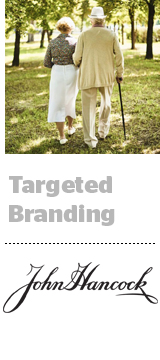
In 2016, financial services brand John Hancock spent 80% of its media dollars on linear television.
Two years later, the brand eschewed TV ads to launch an all-digital awareness campaign last month for its retirement planning services.
That abrupt pivot to digital was driven by a need to find a more addressable audience outside of the traditional age and demo brackets the brand had previously relied on, said Kate Aridini, VP of brand strategy and advertising at John Hancock.
“We needed to be more digital to understand where our customer is,” she said. “We were being outspent by competitors significantly, and looking at consumer behavior, we didn’t have to be in TV anymore.”
The campaign, a digital mini-series starring Pete Holmes and Jamie Lee from HBO’s “Crashing,” was part of a broader evolution in John Hancock’s marketing strategy to educate a wider audience about its retirement services – not just those ready for retirement.
“We’re educating consumers on what we do and how we can help them,” Ardini said. “We have great awareness and trust, but we had an education opportunity and a targeting opportunity to a younger demo that doesn’t necessarily understand what we do.”
To find that broader audience, John Hancock worked with GroupM media agency m/Six. The agency leveraged GroupM’s mPlatform to find audiences who didn’t know the John Hancock brand but demonstrated behaviors, made purchases or indicated an interest in retirement planning, said James Chanter, media director at m/Six.
“We’re not using demographics,” he said. “We’re targeting on attitudes and behaviors. What is a user doing the day before they purchase an investment product or a week or six months before? Understanding that path to purchase allows us to build out high-propensity audiences.”
After finding the right consumers, John Hancock targeted them across Facebook, YouTube, Instagram and programmatically with native and outstream video with sequential messaging about the mini-series, which lived in a hub on Fast Company’s website. John Hancock partnered with Fast Company on production and distribution because the site indexed high with its audience, Ardini said.
Since the campaign was a branding play, John Hancock experimented with longer-form video to keep users engaged with the mini-series. Rather than embracing the six-second digital ad du jour, John Hancock’s videos were three minutes and 30 seconds long.
“It was a little bit of a risk and a gamble because we didn’t have those high-profile TV spots,” she said. “But were seeing a digital-first consumer, so by using a data-driven approach to reach the right audience, our awareness and consideration remained high.”
The risk paid off: Within a week of running the campaign, the videos achieved a 75% completion rate.
“People said people only watch 20-second videos, but that’s not true,” Ardini said. “If the content is right, people will engage with longer-form content.”
And it’s not just about the right content, Chanter added. It’s also about targeting the right consumers with the right message to personalize the experience.
“If we’re reaching the right people, we can cut waste and make our media work harder,” he said. “It’s an awareness program to drive new message association for the brand, but we want that message to be relevant.”
This campaign isn’t John Hancock’s first digital-only branding campaign, and it won’t be the last, Ardini said. In 2017, the brand ran its first digital-only campaign starring former Red Sox player David Ortiz talking about his plans for retirement.
“We learned a lot in terms of finding the right social, programmatic and content partners,” Ardini said. “The Ortiz campaign was creatively led, but this one was just as much media-led to target the right person with the right creative.”
John Hancock hasn’t totally given up on TV – it still demonstrates huge value for the company – but there are unique branding opportunities on digital, such as targeting the right people with sequential messaging, Ardini said. Since shifting toward digital, about 20% of John Hancock’s budget now runs programmatically.
“Our media strategy has been the same for many years,” she said. “We’re continually going to be looking for new, innovative ways to reach a more addressable audience.”
This post was syndicated from Ad Exchanger.

More Stories
Citigroup Scales Back DEI Initiatives
Ticker: CBS News Tweaks Format of CBS Evening News
Wednesday, Feb. 19 Evening Cable News Ratings: Jesse Watters Primetime Wins in Adults 25-54